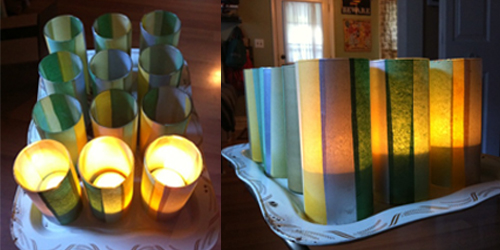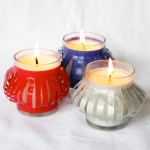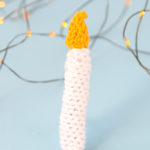The best thing about this project is that I learned to do this when I was a kid using a jelly jar and recycled tissue paper from birthday gifts. After I finished this project last weekend, I even called my mom asking if she remembered the project this is based on, and she still has it in our basement.

Despite the really beautiful results, the process is really simple. The supplies you’ll need are: tissue paper, a paint brush, a cup of water, school glue (Elmer’s), a vase or other glass jar (these are the vases I ordered), and some candles for filling your luminaries.
 Mix your glue and water. About three parts water to one part glue is the right consistency. Cut your tissue paper in to the sort of pieces you’d like to see on your lantern. A mosaic pattern looks cool, but the stripes I used were nice too.
Mix your glue and water. About three parts water to one part glue is the right consistency. Cut your tissue paper in to the sort of pieces you’d like to see on your lantern. A mosaic pattern looks cool, but the stripes I used were nice too.
Lay out some newspaper or paper towel on your work surface. Lots of glue water will drip on to it while you work. Using the paintbrush, paint a small amount of the glue water where you want to place your piece of tissue paper. Lay your tissue paper piece on the glue-covered area, and then paint over the paper again to seal it and make it stick well. Be careful not to over-saturate your tissue paper; it will tear if you’re not careful.
 A note about inevitable bubbles that appear when placing tissue paper: Putting the tissue paper on your glass piece is kind of like putting a bumper sticker on a car. It’s really easy to get air bubbles caught in it. After making 13 of these lanterns, I realized that there are two effective ways to get rid of them. The first, shown in the two left pictures above, involves gently pulling the edges of the tissue paper to smooth out the wrinkles with your hands. To be honest, I ended up ripping a lot of the pieces I was trying to smooth when I did this.
A note about inevitable bubbles that appear when placing tissue paper: Putting the tissue paper on your glass piece is kind of like putting a bumper sticker on a car. It’s really easy to get air bubbles caught in it. After making 13 of these lanterns, I realized that there are two effective ways to get rid of them. The first, shown in the two left pictures above, involves gently pulling the edges of the tissue paper to smooth out the wrinkles with your hands. To be honest, I ended up ripping a lot of the pieces I was trying to smooth when I did this.
A better technique is using the paintbrush on your second pass over the tissue paper to smooth out wrinkles. Just keep brushing from end to end over your tissue paper, and that takes care of it. You ultimately don’t have to worry about small wrinkles because, as you can see when comparing the right-hand picture above with the finished product below, everything smooths out as the lanterns dry.

The last step, of course, is adding and lighting your candles once your lanterns are dry. Tea lights work ok, but I think I’m going to invest in three-inch candles for the wedding, as they’ll be burning all night.






Leave a Reply